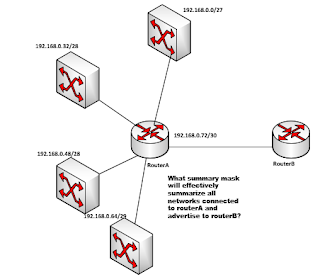The enhanced interior gateway routing protocol is no doubt one of the best routing protocols that you can configure on your network. Apart from its support for VLSM, eigrp supports route authentication and manual summarization, making it one of the fastest internal routing protocols out there. In this demonstration, I will share with us how to implement eigrp to support VLSM and how to use the various eigrp show commands to troubleshoot eigrp routing issues.
LAB: Configure eigrp for the networks in the topology below.
To configure this, I will be using loopback interfaces on router 1 to represent the various networks and then generate a summary address that I will use to advertise all the subnet to router 2. I will be using eigrp autonomous system (AS) 25 on both routers.
On router 1:
First, we configure the interfaceconnecting to router 2
int f0/0
ip add 172.16.0.73 255.255.255.252
no shut
Next, we configure interfaces leading to other networks. For this example, I will be using loopback interfaces to represent those subnets. See below:
int loopback0
ip add 172.16.0.1 255.255.255.224
int loopback32
ip add 172.16.0.33 255.255.255.240
int loopback48
ip add 172.16.0.49 255.255.255.240
int loopback64
ip add 172.16.0.65 255.255.255.252
Still on router 1, next, we implement eigrp and advertise the subnets.
router eigrp 25
netw 172.16.0.0 0.0.0.31
netw 172.16.0.32 0.0.0.15
netw 172.16.0.48 0.0.0.15
netw 172.16.0.64 0.0.0.7
netw 172.16.0.72 0.0.0.3
Next, is to configure the interface on router 2 and advertise the single network connected to router 2
On router 2
interface f0/0
ip add 172.16.0.74 255.255.255.252
no shut
Eigrp implementation on router 2:
router eigrp 25
netw 172.16.0.72 0.0.0.3
Note that the AS number must match on both routers for the eigrp neighbor relationship to work. To see connected eigrp neighbors, use the command sh ip eigrp nei. This will show you established eigrp neighbors as displayed below:
R2#sh ip eigrp nei
IP-EIGRP neighbors for process 25
H Address Interface Hold Uptime SRTT RTO Q Seq
(sec) (ms) Cnt Num
0 172.16.0.73 Fa0/0 13 00:11:46 1015 5000 0 4
R2#
From the output above, router 2 has established neighbor relationship with router 1. Now, lets see if we are receiving the routes advertised on router 1. First, we will use sh ip route (this command shows you all entries in the routing table, irrespective of the routing protocol ) See output below:
R2#sh ip route
Codes: C – connected, S – static, R – RIP, M – mobile, B – BGP
D – EIGRP, EX – EIGRP external, O – OSPF, IA – OSPF inter area
N1 – OSPF NSSA external type 1, N2 – OSPF NSSA external type 2
E1 – OSPF external type 1, E2 – OSPF external type 2
i – IS-IS, su – IS-IS summary, L1 – IS-IS level-1, L2 – IS-IS level-2
ia – IS-IS inter area, * – candidate default, U – per-user static route
o – ODR, P – periodic downloaded static route
Gateway of last resort is not set
172.16.0.0/16 is variably subnetted, 5 subnets, 4 masks
D 172.16.0.48/28 [90/409600] via 172.16.0.73, 00:17:29, FastEthernet0/0
D 172.16.0.32/28 [90/409600] via 172.16.0.73, 00:17:29, FastEthernet0/0
D 172.16.0.0/27 [90/409600] via 172.16.0.73, 00:17:29, FastEthernet0/0
C 172.16.0.72/30 is directly connected, FastEthernet0/0
D 172.16.0.64/29 [90/409600] via 172.16.0.73, 00:17:29, FastEthernet0/0
R2#
Because we used the “no auto summary” command, all networks are being advertised individually. This is good though we will be doing manual summarization shortly .Because eigrp keeps a topology table, let’s see the command to view the eigrp topology table. See below:
R2#sh ip eigrp topology 25
IP-EIGRP Topology Table for AS(25)/ID(172.16.0.74)
Codes: P – Passive, A – Active, U – Update, Q – Query, R – Reply,
r – reply Status, s – sia Status
P 172.16.0.48/28, 1 successors, FD is 409600
via 172.16.0.73 (409600/128256), FastEthernet0/0
P 172.16.0.32/28, 1 successors, FD is 409600
via 172.16.0.73 (409600/128256), FastEthernet0/0
P 172.16.0.0/27, 1 successors, FD is 409600
via 172.16.0.73 (409600/128256), FastEthernet0/0
P 172.16.0.72/30, 1 successors, FD is 281600
via Connected, FastEthernet0/0
P 172.16.0.64/29, 1 successors, FD is 409600
via 172.16.0.73 (409600/128256), FastEthernet0/0
R2#
This command shows you the networks and the paths to get to them. It contains the successor and the backup routs. Since we have only one path to router 1 in this example, the sh eigrp topology 25 command only shows the successor route.
The next command is the show ip route eigrp 25 command. This command only shows routes that were learned via eigrp autonomous system 25.
R2#sh ip route eigrp 25
172.16.0.0/16 is variably subnetted, 5 subnets, 4 masks
D 172.16.0.48/28 [90/409600] via 172.16.0.73, 00:25:24, FastEthernet0/0
D 172.16.0.32/28 [90/409600] via 172.16.0.73, 00:25:24, FastEthernet0/0
D 172.16.0.0/27 [90/409600] via 172.16.0.73, 00:25:24, FastEthernet0/0
D 172.16.0.64/29 [90/409600] via 172.16.0.73, 00:25:24, FastEthernet0/0
R2#
As can be seen, only eigrp learned routes were displayed. Now, let us summarize the route entries on router 2. To do this, we will generate a summary mask for route advertisement on router1. The summary address and mask for the given topology is 172.16.0.0/22. See here for how it was generated. To implement eigrp route summarization on router 1, we enter this one command on the interface connecting to router 2.
int f0/0
ip summary-address eigrp 25 172.16.0.0 255.255.252.0. Now, let’s take a look at the routing table of router 2.
R2#sh ip route eigrp 25
172.16.0.0/16 is variably subnetted, 2 subnets, 2 masks
D 172.16.0.0/22 [90/409600] via 172.16.0.73, 00:01:56, FastEthernet0/0
R2#
From the output above, we can see that t has been greatly reduced to just one entry.
Find another example here.

